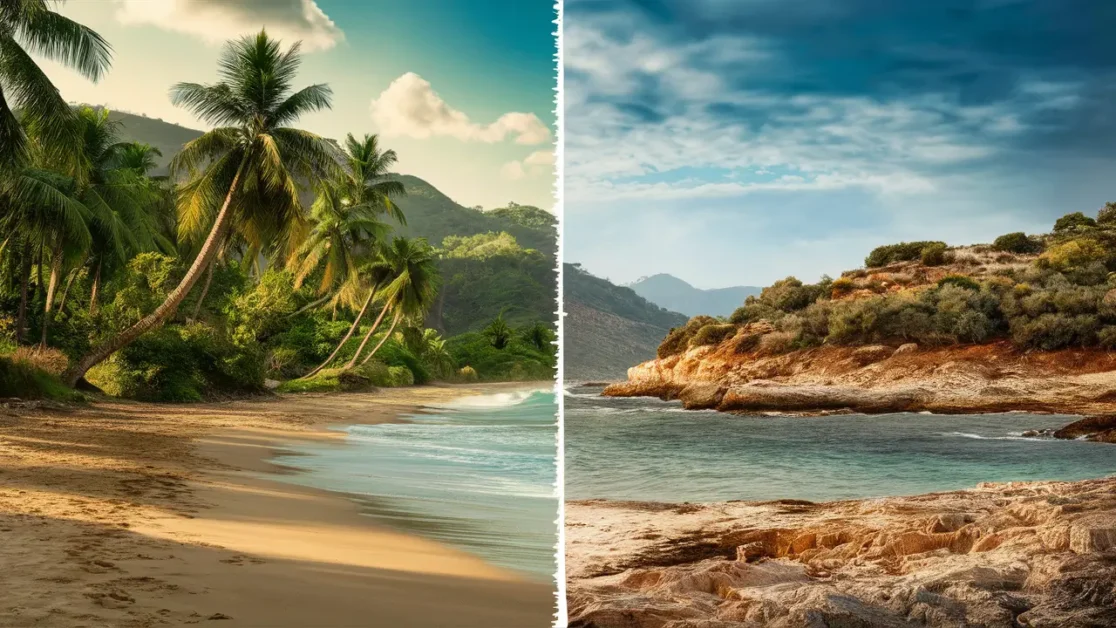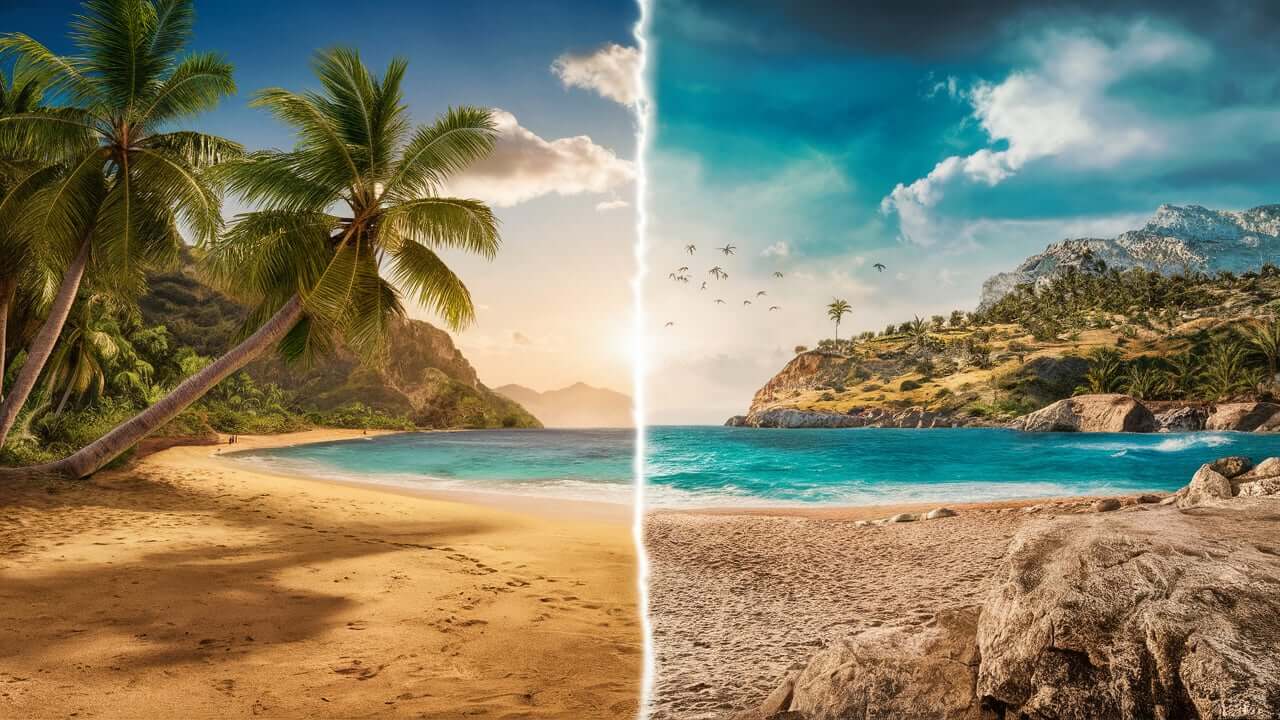Planning a beach trip? Know the difference between Indian beaches and others worldwide.
This knowledge can enhance your experience. Imagine a beach with more than sun and sand.
Picture a blend of culture, wellness, and unmatched natural beauty. Before you pack, read our guide.
It highlights what makes Indian beaches special.
This blog will help you choose a great travel spot. It is for frequent travelers and dreamers alike.
What Are the Key Differences in Beach Environments?
Indian beaches reflect the country’s diversity. They stretch along the Arabian Sea, the Bay of Bengal, and the Indian Ocean.
These beaches range from sandy and rocky to those with mangroves. They all share a warm, tropical climate year-round.
In places like Kerala and Goa, lush greenery enhances their beauty. In contrast, famous beaches in Europe or the Caribbean are cooler and less vegetated.
This difference affects the local plants and animals. Palm trees line Indian beaches, for example. Meanwhile, Mediterranean beaches boast olive groves and scrublands.
Imagine being on Kovalam beach in Kerala. There, coconut palms sway against emerald hills.
This beach contrasts with the French Riviera’s rocky coastline.
The French beaches lack palm trees and feature a more rugged landscape. Check out our guide on essential beach safety and travel tips.
How Do Cultural Experiences Differ?
Indian beaches are unique for their cultural vibe.
They’re bustling with vendors, performances, and ceremonies, especially near temples.
Take Puri Beach in Odisha. It’s more than a spot to unwind; it’s a pilgrimage site for Jagannath Temple visitors.
Australian and U.S. beaches rank entertainment, neglecting cultural significance.
This blend of relaxation and local tradition is what makes Indian beaches special.
When you visit, embrace the local culture. Join in festivals, try street food, and respect nearby religious practices.
Why Do Activities on Indian Beaches Differ?
Indian beaches showcase India’s traditions and resources.
Besides swimming and sunbathing, they offer Ayurvedic treatments, yoga, and temple tours.
For instance, Varkala Beach in Kerala is famous for its temples and wellness retreats.
In contrast, beaches in Hawaii and Thailand focus on water sports like surfing and diving.
They emphasize less on culture and wellness.
Are you a wellness enthusiast? Then, consider an Indian beach for your next retreat. You can enjoy yoga and Ayurvedic treatments by the sea. Check guide on popular beach activities.

What Are the Differences in Beach Infrastructure?
Indian beaches vary in infrastructure by region. Goa, for example, boasts luxury resorts, beach shacks, and easy access to attractions.
Meanwhile, less popular beaches offer fewer amenities and a more basic experience.
Globally, this trend continues. Miami has beachside hotels and restaurants.
New Zealand’s South Island has untouched beaches.
Research amenities before visiting an Indian beach. For comfort, choose popular beaches like Goa’s.
For solitude and beauty, opt for lesser-known beaches in Odisha or the Andaman Islands.
Who Should Visit Indian Beaches?
Indian beaches attract everyone: tourists, adventurers, and bloggers.
Each beach has its unique charm. It’s crucial to match expectations with offerings.
Fans of the Maldives’ resorts and Ibiza’s nightlife will love Indian beaches. They reflect a relaxed vibe and rich culture.
Take a traveler from Spain, for example. They’re used to Ibiza’s vibrant beaches.
Marari Beach in Kerala, but, might catch them off guard. Its emphasis on fishing and Ayurvedic treatments provides a soothing, refreshing contrast.
How Do Indian Beaches Stand Out Globally?
Indian beaches stand out for their beauty, culture, and activities. They include sacred sites, local traditions, and wellness practices.
This sets them apart from most global beaches. In contrast, European and North American beaches focus on luxury and convenience.
Meanwhile, Indian beaches offer a blend of relaxation, culture, and spiritual growth.
Curious about what makes Indian beaches unique? Start planning your trip to see the difference. check out my tips on avoiding common scams
When Is the Best Time to Visit Indian Beaches?
Timing is key for the best Indian beach experience. Visit from November to February.
The weather is pleasant and less humid then. This is different from many places where summer is the peak beach season.
From June to September, India faces its monsoon. It brings heavy rains, making beach activities tough.
But, it’s great for seeing nature’s dramatic changes. So, aim for winter.
Enjoy the best weather and local festivals. They often happen during this season.
Conclusion
Indian beaches stand out from others worldwide. They combine vibrant culture, unique activities, and natural beauty.
This blend offers both relaxation and adventure. Knowing the differences helps you travel better.
Whether you seek culture, wellness, or peace, Indian beaches have something special.
But, don’t take our word for it. Experience it yourself. Plan your beach vacation with these insights for unforgettable memories. Check out our article on motorbike rental scams
FAQS
Indian beaches are unique. They have rich cultures, diverse landscapes, and wellness activities like yoga and Ayurveda. They blend relaxation with cultural immersion.
Indian beaches blend natural beauty, culture, and wellness. They contrast with the recreational focus of many global beaches.
Also, in addition to typical beach activities, Indian beaches offer unique experiences. These include temple visits, Ayurvedic treatments, and local festivals.
The best time to visit Indian beaches is from November to February. The weather is pleasant then, perfect for beach activities.
Infrastructure varies. Popular beaches like Goa have good amenities. Others offer a more rustic, natural experience.
